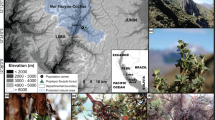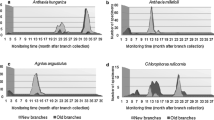Abstract
To control invasive Anoplophora outbreaks, it is crucial to accurately date infestation dynamics. Dating of Anoplophora outbreaks is possible as these xylobiont insects induce wounds in living trees by forming e.g., exit holes. This study investigates to what precision these wounds can be dated with dendrochronological techniques. In an experimental setting, we studied the precision of wound dating on Acer palmatum, an ornamental tree occasionally containing larvae of A. chinensis. We studied the development of wound reactions at the beginning, during and after the growing season, both in relation to leaf phenology and intra-annual tree-ring growth. We found that the precision of dating exit holes is limited due to the highly variable intra-annual tree-ring growth whereby only an accurate distinction can be made between wounds originated during, or after tree-ring formation. The resolution was improved using local growth—the local reactivation of xylem growth around the wound—as a marker for wounds that occurred at the end of the growing season. We conclude that the intra-annual precision of dating Anoplophora outbreaks in Acer palmatum in the temperate North-western European climate is limited to three distinct phases: (i) The period of dormancy and leaf emergence (ca. October until April/beginning of May), when the wounds are located at the tree-ring boundary (ii) The period of tree-ring growth in which wounds are located within the tree ring (ca. end of April/beginning of May until late August/beginning of September), (iii) end of growing season (ca. end of August/September) in which local growth occurs.




Similar content being viewed by others
References
Copini P, Sass-Klaassen U (2010) Dendrochronologische datering van vijf overgroeide uitvlieggaten van de boktor Anoplophora glabripennis in twee takken van een gewone esdoorns (Acer pseudoplatanus). Onderzoeksrapport Dendrochronologisch onderzoek. Wageningen University, Wageningen
Copini P, Sass-Klaassen U, Ouden JD (2010) Dendrochronologische datering van uitvlieggaten van de Aziatische boktor Anoplophora chinensis (Forster). Verkennend onderzoek naar de precisie van dendrochronologische datering van uitvlieggaten. Wageningen Universiteit, Wageningen
Deslauriers A, Rossi S, Anfodillo T, Saracino A (2008) Cambial phenology, wood formation and temperature thresholds in two contrasting years at high altitude in southern Italy. Tree Physiol 28(6):863–871. doi:10.1093/treephys/28.6.863
Dujesiefken D, Liese W (1990) Einfluß der Verletzungszeit auf die Wundheilung bei Buche (Fagus sylvatica L.). Eur J Wood Wood Prod 48(3):95–99
Dujesiefken D, Peylo A, Liese W (1991) Einfluß der Verletzungszeit auf die Wundreaktionen verschiedener Laubbäume und der Fichte. Forstwissenschaftliches Centralblatt 110(1):371–380
Dujesiefken D, Liese W, Shortle W, Minocha R (2005) Response of beech and oaks to wounds made at different times of the year. Eur J Forest Res 124(2):113–117. doi:10.1007/s10342-005-0062-x
Dünisch O, Bauch J (1994) Influence of soil substrate and drought on wood formation of spruce (Picea-abies Karst) under controlled conditions. Holzforschung 48(6):447–457. doi:10.1515/hfsg.1994.48.6.447
Eilmann B, Zweifel R, Buchmann N, Graf Pannatier E, Rigling A (2011) Drought alters timing, quantity, and quality of wood formation in Scots pine. J Exp Bot 62(8):2763–2771. doi:10.1093/jxb/erq443
Forster T, Schweingruber FH, Denneler B (2000) Increment puncher—a tool for extracting small cores of wood and bark from living trees. Iawa J 21(2):169–180
Frankenstein C, Eckstein D, Schmitt U (2005a) The onset of cambium activity—a matter of agreement? Dendrochronologia 23(1):57–62
Frankenstein C, Schmitt U, Waitkus C, Eckstein D (2005b) Wound callus formation—a microscopic study on poplar (Populus tremula L. x Populus tremuloides Michx.). J Appl Bot Food Qual-Angewandte Botanik 79(1):44–51. doi:aspen_bib/30
Frankenstein C, Schmitt U, Koch G (2006) Topochemical studies on modified lignin distribution in the xylem of poplar (Populus spp.) after wounding. Ann Bot 97(2):195–204. doi:10.1093/aob/mcj030
Grotta AT, Gartner BL, Radosevich SR, Huso M (2005) Influence of red alder competition on cambial phenology and latewood formation in Douglas-fir. Iawa J 26(3):309–324
Grünwald C, Stobbe H, Schmitt U (2002) Developmental stages of callus formation on wound edges of broad-leaved trees. Forstwissenschaftliches Centralblatt 121(2):50–58
Haack RA, Hérard F, Sun J, Turgeon JJ (2010) Managing invasive populations of Asian longhorned beetle and citrus longhorned beetle: a worldwide perspective. Annu Rev Entomol 55(1):521–546. doi:10.1146/annurev-ento-112408-085427
Hartig T (1860) Beitrage zur physiologischen Forstbotanik. Allgemeine Forst Jagdzeitung 36:257–261
Hérard F, Ciampitti M, Maspero M, Krehan H, Benker U, Boegel C, Schrage R, Bouhot-Delduc L, Bialooki P (2006) Anoplophora species in Europe: infestations and management processes. EPPO Bulletin 36(3):470–474. doi:10.1111/j.1365-2338.2006.01046.x
Kriebel HB, Wang CW (1962) The interaction between provenance and degree of chilling in bud-break of sugar maple. Silvae Genetica 11:125–130
Kuroda K, Shimaji K (1984) The pinning method for marking xylem growth in hardwood species. Forest Sci 30(2):548–554
Ladefoged K (1952) The periodicity of wood formation. Danske Biologiske Skrifter 7(3):1–98
MacLeod A, Evans HF, Baker RHA (2002) An analysis of pest risk from an Asian longhorn beetle (Anoplophora glabripennis) to hardwood trees in the European community. Crop Prot 21(8):635–645. doi:10.1016/S0261-2194(02)00016-9
Michelot A, Breda N, Damesin C, Dufrene E (2012) Differing growth responses to climatic variations and soil water deficits of Fagus sylvatica, Quercus petraea and Pinus sylvestris in a temperate forest. For Ecol Manage 265:161–171. doi:10.1016/j.foreco.2011.10.024
Norby RJ, Hartz-Rubin JS, Verbrugge MJ (2003) Phenological responses in maple to experimental atmospheric warming and CO2 enrichment. Glob Change Biol 9(12):1792–1801. doi:10.1046/j.1529-8817.2003.00714.x
Nowak DJ, Pasek JE, Sequeira RA, Crane DE, Mastro VC (2001) Potential effect of Anoplophora glabripennis (Coleoptera: Cerambycidae) on urban trees in the United States. J Econ Entomol 94(1):116–122
Ortloff W, Goldammer JG, Schweingruber FH, Swetnam TW (1995) Jahrringanalytische Untersuchungen zur Feuergeschichte eines Bestandes von Pinus ponderosa DOUGL. Ex LAWS. In den Santa Rita Mountains, Arizona, USA. Forstarchiv 66:206–214
Oven P, Torelli N, Shortle WC, Zupancic M (1999) The formation of a ligno-suberised layer and necrophylactic periderm in beech bark (Fagus sylvatica L.). Flora 194(2):137–144
Rasband WS (1997–2012) ImageJ. U.S. National Institutes of Health. http://imagej.nih.gov/ij/
Sass U, Killmann W, Eckstein D (1995) Wood formation in two species of dipterocarpaceae in Peninsular Malaysia. Iawa J 16(4):371–384
Sass-Klaassen UGW, Copini P (2008) Dendrochronologische datering van uitvliegjaren van de boktor Anolophora chinensis in een stamschijf van een esdoorn (Acer sp.) uit het Westland, p 6
Sawyer A (2007) Infestation dynamics of the Asian longhorned beetle in the United States. In: Gottschalk KW, Kurt W (eds) Proceedings, 17th U.S. Department of Agriculture interagency research forum on gypsy moth and other invasive species 2006. vol Gen. Tech. Rep. NRS-P-10. Department of Agriculture, Forest Service, Northern Research Station, Newtown Square, p 117
Schmitt U, Moller R, Eckstein D (2000) Seasonal wood formation dynamics of beech (Fagus sylvatica L.) and black locust (Robinia pseudoacacia L.) as determined by the “pinning” technique. J Appl Bot-Angewandte Botanik 74(1–2):10–16
Schmitt U, Jalkanen R, Eckstein D (2004) Cambium dynamics of Pinus sylvestris and Betula spp. in the northern boreal forest in Finland. Silva Fennica 38(2):167–178
Schneuwly DM, Stoffel M (2008) Tree-ring based reconstruction of the seasonal timing, major events and origin of rockfall on a case-study slope in the Swiss Alps. Nat Hazards Earth Syst Sci 8(2):203–211
Schweingruber F (1996) Tree rings and environment dendroecology. Peter Haupt, Switzerland
Stoffel M, Lievre I, Monbaron M, Perret S (2005) Seasonal timing of rockfall activity on a forested slope at Taschgufer (Swiss Alps)—A dendrochronological approach. Zeitschrift für Geomorphologie 49(1):89–106
Swetnam TW, Allen CD, Betancourt JL (1999) Applied historical ecology: using the past to manage for the future. Ecol Appl 9(4):1189–1206. doi:10.1890/1051-0761(1999)009[1189:aheutp]2.0.co;2
Van der Gaag DJ, Sinatra G, Roversi PF, Loomans A, Hérard F, Vukadin A (2010) Evaluation of eradication measures against Anoplophora chinensis in early stage infestations in Europe. EPPO Bulletin 40(2):176–187. doi:10.1111/j.1365-2338.2010.02381.x
Van der Werf GW, Sass-Klaassen U, Mohren GMJ (2007) The impact of the 2003 summer drought on the intra-annual growth pattern of beech (Fagus sylvatica) and oak (Quercus robur). Dendrochronologia 25:103–112
Wolter KE (1968) A new method for marking xylem growth. Forest Sci 14(1):102–104
Acknowledgments
We thank Robbert Blanken, Mathieu Decuyper, Leo Goudzwaard and John van der Lippe (Unifarm) of Wageningen University for their support in field and lab work. We are grateful to Nico Mentink and Brigitta Wessels-Berk of the Dutch National Plant Protection Organization for their valuable contributions to this project. We thank Sylvia Grommen for making Fig. 2 and Alice Welch of the United States Department of Agriculture for providing the photo of Fig. 1a. This work was supported by the C.T. de Wit Graduate School for Production Ecology and Resource Conservation and the Dutch National Plant Protection Organization of the Ministry of Economic Affairs, Agriculture and Innovation.
Author information
Authors and Affiliations
Corresponding author
Additional information
Communicated by A. Braeuning.
Rights and permissions
About this article
Cite this article
Copini, P., Sass-Klaassen, U., den Ouden, J. et al. Precision of dating insect outbreaks using wood anatomy: the case of Anoplophora in Japanese maple. Trees 28, 103–113 (2014). https://doi.org/10.1007/s00468-013-0933-6
Received:
Revised:
Accepted:
Published:
Issue Date:
DOI: https://doi.org/10.1007/s00468-013-0933-6




